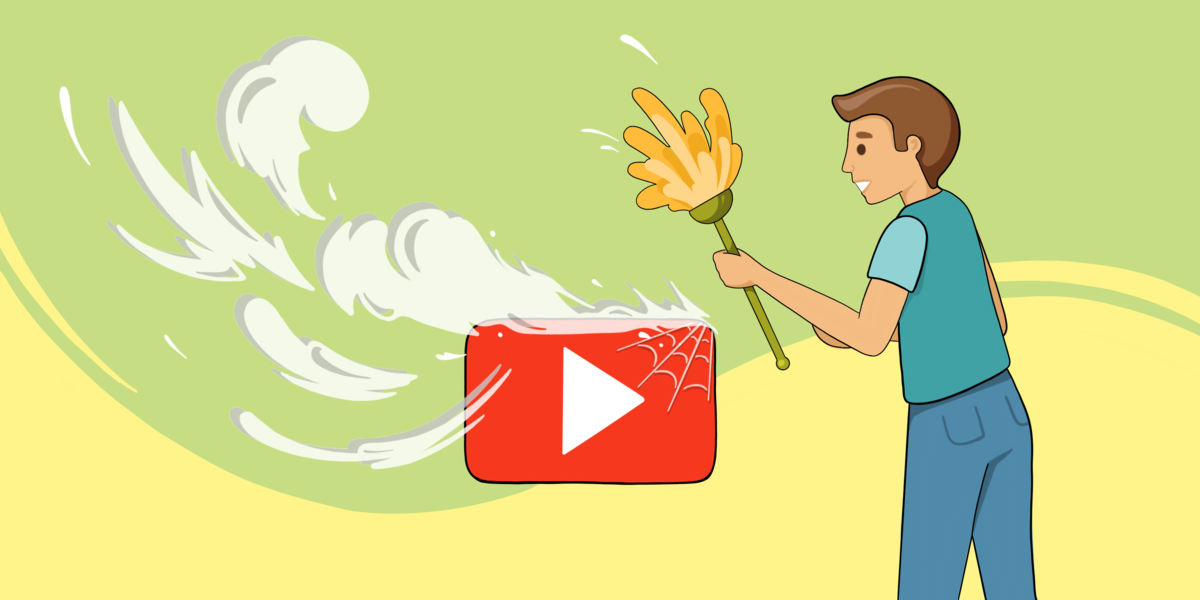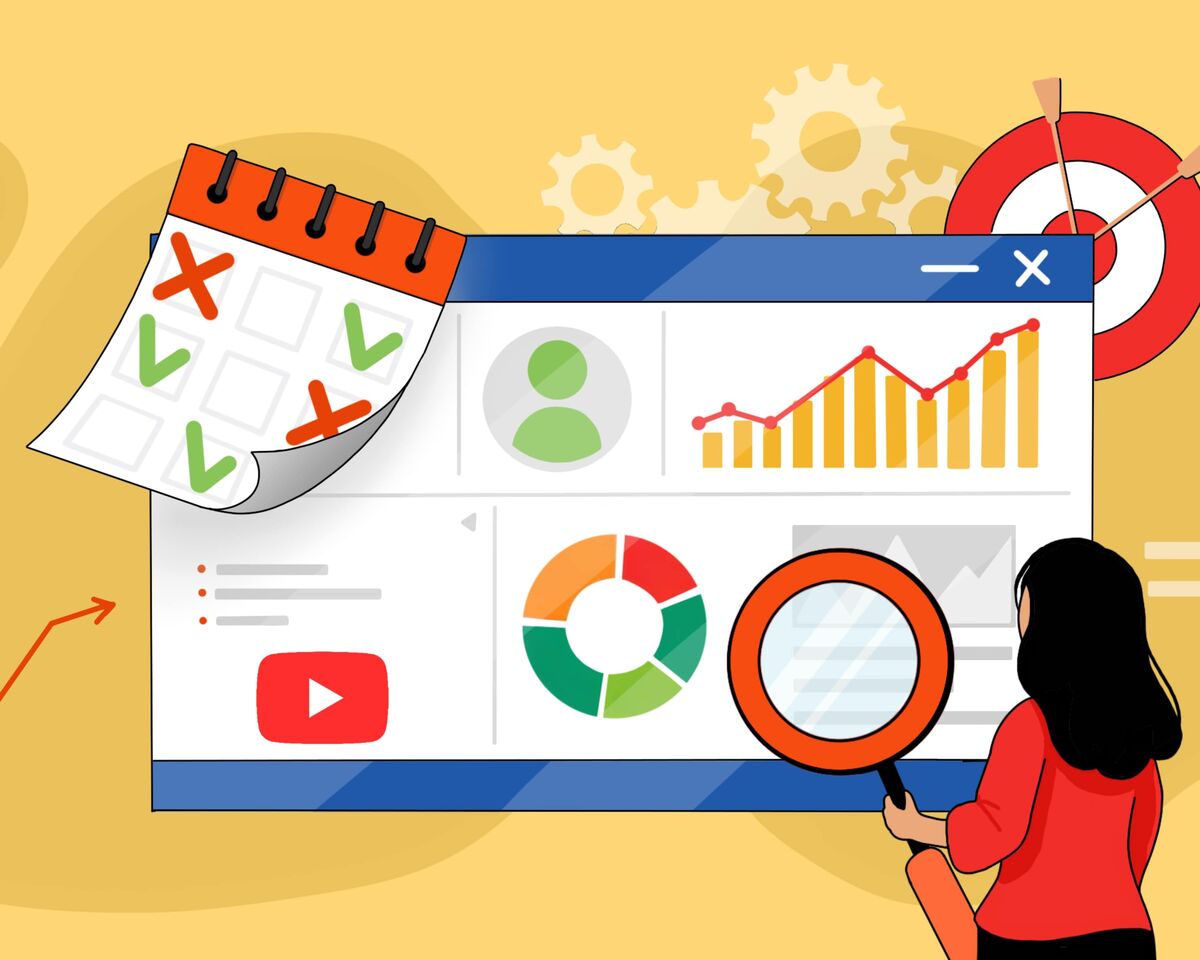How to Revive an Old YouTube Channel

What do you feel when you rewatch old videos? Have you ever looked at an ancient clip and thought to yourself, 'OMG, this needs to be deleted!' Channels become outdated, topics become irrelevant, and you change - it's a normal part of life. But what if, under these circumstances, the desire to create returns? Maybe you should not rush to delete your older videos and create new channels.
New or old one?
There is no exact data from YouTube on how long their algorithms stop working with an inactive channel. However, the help center states that a channel is considered inactive after six months of no content uploads and active engagement from the creator, such as comments and likes.
Another important question is how many subscribers are left on your old channel? Of course, it's up to you to decide what number will be an argument in favor of saving the channel. Our recommendation is that if you haven't reached the monetization threshold on your old channel, it's probably better to start a new one.
How to revive an old YouTube channel?
Let's say you want to start a vlog that focuses on a completely new subject. Having a new theme means a new channel, as mixing niches and themes can be detrimental. However, we should take a look at another important concept: YouTube will view your new channel and your older one equally.
Therefore, you don't have to get rid of your old channel, even if you don't plan on returning to it. Use the groundwork that already exists. There are pitfalls in this "revival," such as unsubscriptions. Viewers who subscribed to you before you stopped running the channel followed you for completely different content. As soon as they see irrelevant content from a forgotten creator in their recommendations, they will likely unsubscribe if the content doesn’t meet their needs.
But don't stress it, there will be viewers who want to follow you on this new journey. It's just that their number will most likely be significantly smaller than the number of subscribers at the time of the channel's revival. Another important point is that YouTube will have a hard time immediately figuring out where to position and recommend your videos. But don’t fret because time solves everything, so just give the algorithms a month or even more to recognize the new theme.
Another situation may arise. Let’s say that you decided to return to your channel with the same theme, with the same host and content. Then go ahead and come back!
It is important that your audience receives the same content they are familiar with. If you had a miscellaneous channel before, keep creating content that will fulfill your audience's desires. But even when returning to old topics and your relevant audience, there are some nuances.
First of all, ask yourself: how relevant is my channel today?
Let's say you made videos about the TV series "Misfits," which ended almost ten years ago. In this case, you should realistically evaluate how many people in 2023 would be interested in looking at content based on characters they may have already forgotten. You can still try to reinvigorate an old niche but just be aware of the pitfalls.
You can also try to revive the channel with videos from the same niche but slightly similar topics. For example, maybe you pivot to more current TV series like: "Brassic," "The Boys," "The Umbrella Academy," and so on. The main thing is that they are relevant today.
Use logic: if your viewers were interested in these topics, what could be interesting now?
Also, remember that for YouTube’s algorithm, an old forgotten channel will look the same as a new one, so start making videos as if you have zero subscribers: make simple and interesting videos, maintain regularity, work on channel design and search engine optimization (SEO).
To quickly create a video that will raise your channel from the dead, there is a small life hack. Look at which video in the past has taken off, but has already fallen out of YouTube’s algorithms.
Here are several options:
-
You can delete it and publish it again. It may not take off now, but it's worth a try. Just make sure to consider its relevance. If it's a top 10 list of Obama's funniest jokes, there's no point in deleting and re-uploading it. The former president's name isn't as popular online as it was 5-7 years ago. If it's a more neutral video not tied to any particular trend or topic, feel free to upload it again.
-
If YouTube has already shown interest in a particular video, try re-editing it with a similar title or incorporating current trending elements. If the video has changed significantly after editing, there's no need to delete the original. But if the video still closely resembles the original or has an identical title, it should be deleted.
-
The most effective option is to reimagine an old viral topic with a new approach. This way, you can avoid duplicating content while creating a fresh, high-quality video that incorporates current trends.
In the first few months of relaunching your channel, it's important to focus on easily accessible content. Don't immediately return to YouTube with highly polished, complicated videos. It's important to attract people with easy and accessible content.
This is good for a simple reason: it allows you to return to creating content without stress. In the first couple of months, it's natural to want to produce videos out of enthusiasm, but that energy quickly dissipates, and you may burn out. Additionally, viewers won't be overloaded with complex, sophisticated content.
How can you determine which videos won't be too taxing but will still attract enough attention and generate interest?
One way to determine what kind of content to produce is by looking at what's currently popular on YouTube. Use the platform's search function to see what people are watching and what kind of content is being produced. Additionally, think about your own interests and expertise. What topics or skills can you share with your audience in a way that's engaging and approachable?
By combining current trends with your own knowledge and passions, you can create videos that strike a balance between accessibility and interest. Finally, consider asking your audience for feedback on what types of content they enjoy and find most valuable. This can help guide your content creation strategy and ensure that you're producing content that your viewers will enjoy and want to share.
Below we breakdown two strategies:
- Create fun and accessible video content, meaning videos that are intended to attract new and active audiences. Not just for those who were once subscribed.
- Create videos that are targeted towards your old loyal audience. Here, a format that strengthens your connection with viewers through personal storytelling will be appropriate. For example, a video on the topic of why you disappeared? How did burnout happen? This will allow people to get to know you better and empathize.
To avoid getting lost in tasks related to restoring activity on your old channel, focus on two questions:
- What is the goal of your return? In other words, why did you come back, what do you want from the channel and the viewers, what is the purpose of your content, and what are you currently striving for?
- What is the strategy for achieving this goal? How often will videos be released, in what format, and what steps will help you establish comfortable work on the channel.
The sequence at all stages should be of high quality. You should film all the time, but it's not necessary to upload videos every day. Just do it regularly. You need to develop relationships with the audience, but it's not necessary to respond to every comment. You need to work on SEO for your content, but don't get bogged down in it.
Set a convenient schedule to integrate harmoniously into work.
How do you know if you are moving in the right direction?
To understand that you are moving in any direction, it is necessary to study the channel's analytics. Keep in mind that there will be no quick results, and the first month or two will likely be quiet for you.
But as soon as some movements begin, remember that you need to measure every little metric because that's the only way you'll know if the strategy is really working.
- Pay attention to the number of views
However, under no circumstances should you compare them with the number of views that your channel used to receive before it became abandoned. Now you have a fresh start, so you should compare your views with your latest uploads. If there is growth, then you are heading in the right direction.
- Pay attention to watch time
This is a key indicator for the platform to promote your videos. If the watch time is less than 50% , then you should think about your topics and format of your content. Obviously, they don't really grab the viewer's attention. But if the retention is more than half the time of the video, then everything is fine, and you are on the right track.
- Pay attention to CTR
Clicks are what tell us how many people are interested in the topic at hand, and retention shows us how well the topic is being covered. If you have a lot of clicks but weak retention, then you are creating good thumbnails and titles, but the videos themselves are not satisfying people. Conversely, if your retention is good but you're not getting many clicks, then your video packaging may be suffering.
Keep in mind that during the first few weeks, when only a few dozen people are watching you, the click-through rate can be very high. So don't rush to analyze your content in the first month of consistent uploading.
- Pay attention to the number of impressions.
All actions to attract and retain an audience should be aimed at increasing the number of impressions on YouTube. However, it takes time for a channel to gain traction, so this metric should be evaluated last in your analytics.
These few metrics are just the beginning. Ideally, you should devote a decent amount of time to analytics and analyze everything that happens on the channel at least once a week.
The main rule is, do not look at the overview statistics for the last 28 days. It will include videos that you uploaded three or four years ago. Only look at the expanded analytics. Click the "More" button and study the graphs.
Why won't the overview statistics help? You may not notice that you are moving in the right direction because the comparison with the old result will always be disappointing. Only fresh analytics on specific videos will work.
And one more problem: due to your return, a video that was released five years ago may suddenly shoot up. And you will be happy because you are doing everything right, but you cannot rely on this. Overall statistics will show that you did a great job, but views will belong to the old content.
Finally, an important note: you won't get feedback in the first few days after uploading a video, but continue to regularly check. If your audience suddenly starts to react negatively, with comments like; "it used to be better,". Don’t get disappointed, rely on your statistics to see if your strategy is working or not.
How to evaluate new results?
There will be many things that don't go according to plan. You just need to be prepared for this and work with each obstacle. Take a deep breath, think about what you can do, and start implementing it without panic.
If there are no hiccups, this should actually make you more cautious, not more comfortable. Glitches will happen, and that's normal. The channel is trying to gain traction, so the algorithm can and will fluctuate, just like your views. It should not bother you that each new video is not getting more views than the previous one. Ups and downs at this stage are normal.
What is the main difference between launching a channel from scratch and bringing back an old channel?
You already have viewers and you need to stir them up again, rekindle their interest in your content. If you can do this, then they could be the driving force that brings your channel back to life. The main thing is not to get fixated, the focus should always be on new audiences.
Should you remove the old videos?
This decision always remains up to you. But we will provide you with some advice below. First, you should categorize old videos into several categories:
- Old videos that don't get views.
- Old videos that make you cringe.
- Old videos on different topics.
Let's go through each point separately.
- Should you delete videos that don't perform well?
YouTube is a long game, so it's best not to delete videos. It may take a long time for a video to suddenly take off. This could take a month, two, six, or even a year.
Your video may just not be timely, or the video may have not reached its target audience, but sooner or later, every video will find its audience.
In addition, don't forget that any video generates watch hours and traffic, even if it's minimal, and when you delete them, the metrics disappear as well.
- Do you need to delete old videos that embarrass you?
Here, we are talking about videos that you think make you look silly or stupid, or that make you think you could have done better. The secret is that YouTube doesn't care how bad you were before. These videos don't hurt you in any way, and they still attract traffic. In addition, your subscribers can appreciate your growth by looking at where you started and where you are now. These changes can work in your favor and even increase audience loyalty and bring you closer to them.
What about titles and thumbnails? If you've changed the style of your channel, whether or not to change the thumbnails and titles is entirely up to you. The same goes for titles. On the one hand, it's cool to see the growth of your channel, but on the other hand, it can interfere with your overall design and ruin the look.
The YouTube algorithms won't be affected after a name or thumbnail change. This only impacts viewers. If viewers start watching your videos more often and responding to them after a thumbnail or title change, there is a chance that the video will take off. But again, this depends solely on the viewers' reaction.
- Should videos on different topics be removed?
Let’s revisit the concept that mixing topics on one channel doesn't help a channel grow. Deleting videos that don't fit the channel's theme can even be useful because those videos attract different, often non-target audiences.
On the other hand, there is no need to delete them. You can simply hide them so as not to deprive yourself of the traffic and views that have already been gained. Let the watch time and views remain, and let the topics float into oblivion because deleting videos will not help erase memories of them from the platform's algorithms.
In the future, always stick to only one niche and topic on one channel.
Remember that different videos with different values and fundamentally different audiences cannot work on the same channel because they may attract viewers or subscribers, but your other videos will not interest them. This may lead to a flood of unsubscribes and horrible watch time.
Reviving an old channel is a question many YouTubers have had. Creators often start working on their channels with enthusiasm, creating videos, but over time, if they don't feel a return on their investment, they start to become disillusioned with their idea. This leads them to abandon their channel.
Always remember that on YouTube, nothing happens quickly. This is done specifically so that the most impatient and lazy creators leave early on. So our advice is – learn to maintain your enthusiasm, stay consistent and creative. Sooner or later, all your hard work will pay off.




